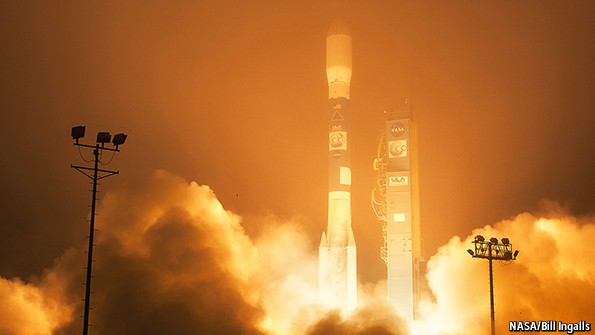A newly launched satellite will reveal even more about the planet’s workings than originally planned
Jul 5th 2014 | From The Economist
THE ten-and-a-half minutes it took a Delta 2 rocket to lift OCO-2 from Vandenberg Air Force Base in California to a parking orbit 190km above Earth on July 2nd would have been too long for most people (even Tibetans) to hold their breath. But you could not have blamed the team of scientists and engineers that built the satellite for wanting to. Five years ago they watched as the original OCO—the Orbiting Carbon Observatory, designed to map the concentration of atmospheric carbon dioxide around the world and its change over time—lifted off from the same place, only to end up sunk in the sea off Antarctica after the rocket carrying it failed.
Thanks to money made available by America’s fiscal stimulus, OCO is a rare example of a lost mission that got a second chance. A near-identical version—a carbon copy, you might say—was rushed into production. After a second atmospheric-research satellite was lost because of another problem with the make of rocket that had served OCO so poorly, though, the replacement had to wait for a few years while a more reliable alternative was procured.
That delay produced not just a safer launch, but also a better satellite. In 2013 the devices (called reaction wheels) used to point Kepler, a space telescope, at its target stars started to fail—devices on which OCO-2, too, would rely. They have been modified. And OCO-2 has also become even more scientifically promising in the interim—not because of better instruments, but because of a new appreciation of what the old instruments can do.
The sweet glow of success
The point of mapping carbon-dioxide levels is to understand the processes that move the gas into and out of the atmosphere—to identify what scientists call sources and sinks, and to see how they vary over time. The reason that only about half the carbon dioxide which people pump into the air stays there is that natural sinks mop the rest up. Some is absorbed by seawater and some by plants. Were it not for this beneficence, the problems of man-made climate change would be much more dire than they are. Better understanding of the location and capacity of the sinks—grasslands and forests, temperate and tropical—is thus not just a matter of scientific interest but of planetary prudence.
Measuring the carbon-dioxide level in the overlying atmosphere, though, reveals only net flows—the amount sucked up minus the amount emitted. This net flow is sensitive both to how much photosynthesis the plants in a given place are doing and also to how much respiration—combining carbon with oxygen to turn it back into carbon dioxide—is going on. If such measurements were to show an area becoming a weaker sink, it would not necessarily be possible to tell whether that was because the rate of photosynthesis was dropping or, rather, the rate of respiration (much of it by soil microbes) was growing—a difference that could matter a lot.
In the years between OCO’s demise and OCO-2’s launch it has turned out that, as well as measuring carbon-dioxide levels, the spacecraft can also measure photosynthesis directly. The molecular machinery which uses sunlight to make energy-rich carbon compounds relies on chlorophyll to collect the sunshine in the first place. The flow of energy from the chlorophyll into the rest of the machinery has to be regulated carefully, and part of the process of regulation is for the plant to emit surplus energy by letting the chlorophyll fluoresce. Measurements of fluorescence made in laboratories provide a powerful way of seeing into the leaf and monitoring its molecular behaviour.
In the past couple of years researchers have found that instruments like those on OCO-2, designed to measure the abundance of gases by detecting the wavelengths at which they absorb infrared light, can pick up some of this fluorescence. Indeed it is a source of noise that the people making the gas measurements need to understand in order to get their results. Data from satellites with instruments similar to OCO-2’s have recently made possible broad assessments of where photosynthesis is going on most vigorously (America’s corn belt, unsurprisingly). Applied to the more copious and specific data from OCO-2, these techniques will allow precise mapping of photosynthesis, as well as of net carbon flows. That should allow researchers to estimate the amount of carbon being taken up by plants, and thus infer the rate of respiration in the same area. This will greatly improve models of how the carbon cycle works both in specific places and globally.
A satellite kitted out with instruments specially designed to measure fluorescence would be able to do more: it could give a much better sense of how efficiently plants are photosynthesising, and provide indications of what types of stress—a lack of water or nutrients, say, or excessive temperatures—were afflicting them. FLEX (Fluorescence Explorer) is a European Space Agency satellite designed to provide such information at a resolution of as little as 300 metres—the size of a big field. If it is given the go-ahead next year, it might be in orbit by the early 2020s. If researchers can hold their breaths till then, they will be able to measure the breathing of the whole world as a result.

